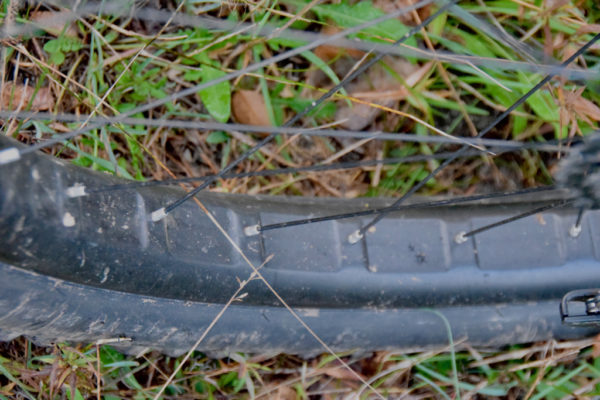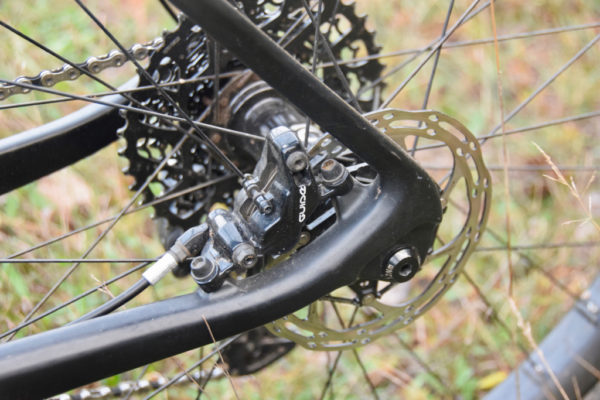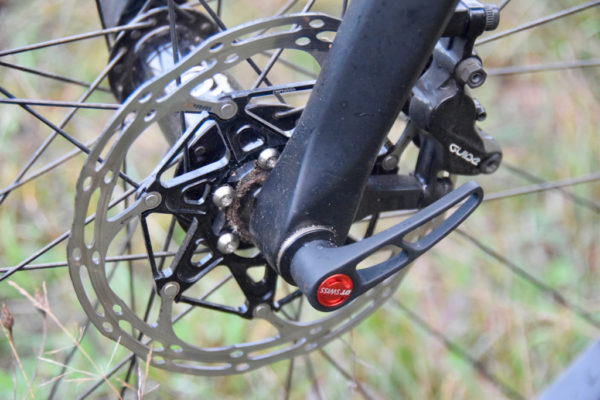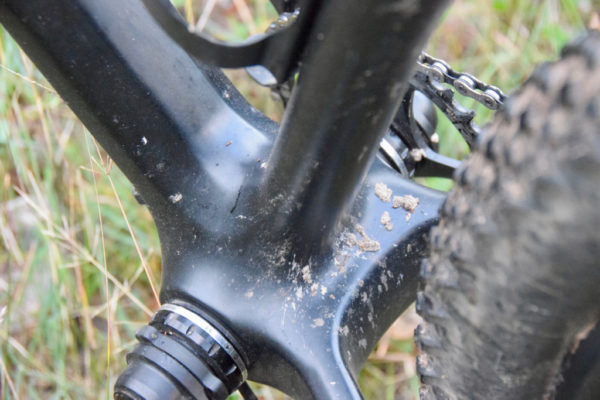
Bearclaw Balthazar shown with my seat, seatpost and stem instead of the stock setup.
Bearclaw Bike Co. is a name that many people may not be familiar with but I am guessing if you follow the fat bike race scene (in Michigan) it will be a name you start to see a whole lot more. The first offering from Bearclaw is the Balthazar and it is an unapologetic race bike for all four seasons. The frame is setup to run 27.5+, 29+ or 26 x 4″ (likely to fit larger tires but I will be testing that later). It is also the “brainchild of Chet Bearclaw, a tech entrepreneur, astronaut, musician, futurist, and ultra-endurance athlete.”
This isn’t the normal long term review that you see for bike on Fat-Bike.com. I was hooked up with the large frame and 29+ wheel version of the Balthazar for about three weeks this fall right before the leaves started to really fall and will be getting it back for several more weeks of testing this winter in its 26 fat setup. No, I am not going to be able to test this out for as extended of period as a normal test, but this format is pretty rad because it allows testing it during prime dirt and also prime winter conditions.
The Balthazar comes in three different build kits starting with a SRAM GX build for $4,500 and moving up to a SRAM XX1 build that goes for $8,500. I got the GX build which was by no means a low end setup. It came with some pretty sweet carbon wheels using Industry Nine hubs and weighing in at about 25 lbs. The cool thing is for that price you can pick between three different wheel setups: the “Little Chet” 27.5+, the “Big Chet” 29+ or the ricoCHET fat bike wheels. You can snag a second pair of wheels to have a 4 season race rocket of a bike that can be raced in any category competitively.

The 29+ wheelset I got to ride was well built and a great option for day-to-day riding without giving up much performance on race day. The carbon rims had reinforced and offset spoke holes to keep spoke tension more equal. Spokes were 14/15 gauge Sapim and the hubs were Industry Nine so all of the components are top shelf and should hold up very well. The frame uses 157/197mm spacing

The frame doesn’t use any crazy huge tubes but is plenty stiff where it needs to be with great drive train efficiency and no noticeable issues with flex when pushing the bike hard in corners and throwing it around on the trail. Luckily the seat stays are flattened and give the rear end of the bike a comfortable ride.

Cable routing is sensible with external routing for the rear brake line and the rear derailleur cable runs internally through the top tube but externally down the seatstay. This gives the bike a nice clean look but isn’t going to be a huge headache when it comes to maintenance down the line.

The dropouts and brake caliper mounts were tidy with the rear brake nicely tucked onto the chainstay. I liked the fact that they used a DT thru axle on the front and a minimal bolt thru axle on the rear. In keeping with the race aspirations of this bike the bolt on rear saves a bit of weight and the front axle is just a quality choice that adds convenience with minimal weight. I was really impressed with the addition of either a 1175 or 1180 SRAM cassette (forgot to check which specific one it was) instead of a 1150. The 1150 works great but the 1175 and 1180 drop 70-80g so it is a nice addition bit of weight savings.

For a “budget” build there were some really nice touches like the use of the 2-piece Centerline rotors and SRAM Guide RS brakes. Once again, to go with the racier intentions the rotors were 160mm up front and 140mm in the rear to balance out the braking and save weight.

Clearance was ample even with the big diameter 29+ wheels. The finish quality of the frame seemed very good with no noticeable issues or defects. All of the hardware (like the seat clamp, derailleur hanger…) was good quality also. Visually the bike is really attractive with matching pink accents and a really nice head tube badge. The bike also comes in a “Miami Spice Purple” color which is kind of a pinkish purple. Contrary to how that may sound, it actually looks pretty sweet.
I liked seeing a standard threaded bottom bracket to avoid any creaking issues down the line. I am a big fan of the Raceface Turbine Cinch crankset. They are reasonably light, stiff and durable. Add on flexibility offered by the direct mount chainrings and this is probably my favorite crankset on the market right now.
Another spec I really liked were the Vittoria Bombolini tires. This was the first time I had spent extensive time on them and I came away very impressed. They seemed to roll as well as the best rolling 29+ tires out there but had very good drive and cornering traction. They didn’t exhibit any weird behavior and broke free gradually when you reached their slip point. While by no means a mud tire, they also worked surprisingly well in muddy conditions packing up less than a lot of other similar tires.
To get the bike dialed in for myself I needed to install a setback seatpost and longer stem. That has more to due with me being a funky sized person than the bike being weird. The changes put me in a really good aggressive race position (befitting the bike’s intent) with good weight distribution between the front and rear wheels.
The handling of the bike is definitely fast as you would expect with a 70.5 degree head tube angle. It seems to just want to dive into corners. In tight singletrack the bike feels amazing, just asking you to brake late and lean the bike over to see where the limit of traction is. When right at the ragged edge of traction that responsiveness was especially welcome because you could feather the edge of control just that much more. The flip side of this is that it didn’t seem to have great straight line stability. During the summer months this isn’t a big deal (actually a big advantage when ripping tight singletrack) but I am wondering how this will translate to winter riding where additional stability is really helpful due to slipping and sliding around. I will definitely report back on this after some winter testing.
The bike is definitely stiff when getting on the pedals with no noticeable wind-up or sway in the bottom bracket. Ditto for the front end and flex when steering and throwing the bike around. You just point the bike and it goes right where you want it. The rear end of the bike is fairly comfortable (for a hardtail) but the fork is pretty darned stiff. From a performance standpoint that makes for crisp handling and no issues with the fork waggling back and forth on bumps and during hard braking. The flip side is that a lot of the shock is transmitted into the handlebars. This isn’t a problem if you are riding/racing for less than three hours but I wouldn’t want to do a 100 miler on this bike in this configuration. That is where a suspension fork would be a big advantage. Speaking of which, the geometry is setup nicely to accommodate a suspension fork. The rigid fork is about 20-40mm shorter than a Bluto (depending on travel) but only has 45mm of rake. When you go to a suspension fork which generally has more rake (typically 51mm), your handling will stay fairly similar even though the front end will get raised up and slacken the head tube angle.
This bike is intended as a four season race rocket and early indications are that it succeeds admirably on that front. I wouldn’t hesitate to line up at most any midwestern race on this bike during the summer months. Winter performance is still to be tested so I will report back about that soon. The bike seems to offer good value especially considering some of the small touches included like the lighter rotors, cassette, bolt on rear thru axle and super high quality hubs. If you are in the market for a racy bike, definitely check out the guys at Einstein Cycle and their Bearclaw Balthazar.
For more information about Bearclaw visit – www.bearclawbicycleco.com